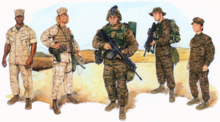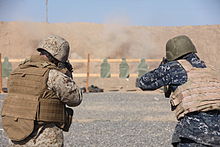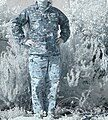
The Desert Battle Dress Uniform (DBDU) is a U.S. arid-environment camouflage battle uniform that was used by the United States Armed Forces from the early 1980s to the early to mid 1990s, most notably during the Persian Gulf War. Although the U.S. military has long since abandoned the pattern, it is still in widespread use by militaries across the world as of the early 2020s.

The Battle Dress Uniform (BDU) is a camouflaged combat uniform that was used by the United States Armed Forces as their standard combat uniform from the early 1980s to the mid-2000s. Since then, it has been replaced or supplanted in every branch of the U.S. Armed Forces.
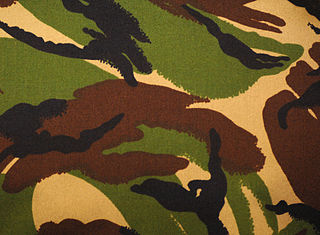
Disruptive Pattern Material (DPM) is the commonly used name of a camouflage pattern used by the British Armed Forces as well as many other armed forces worldwide, particularly in former British colonies.

Tiger stripe is the name of a group of camouflage patterns developed for close-range use in dense jungle during jungle warfare by the South Vietnamese Armed Forces and adopted in late 1962 to early 1963 by US Special Forces during the Vietnam War. During and after the Vietnam War, the pattern was adopted by several other Asian countries. It derives its name from its resemblance to a tiger's stripes and were simply called "tigers." It features narrow stripes that look like brush-strokes of green and brown, and broader brush-strokes of black printed over a lighter shade of olive or khaki. The brush-strokes interlock rather than overlap, as in French Lizard pattern (TAP47) from which it apparently derives.

MultiCam is a camouflage pattern designed for use in a wide range of environments and conditions which was specifically developed and is produced by American company Crye Precision. As a result of the pattern's effectiveness across disparate environments and regions, it has found extensive adoption globally. Variants of it, some unlicensed, are in use with armed forces worldwide, particularly with special operations units.

The Desert Camouflage Uniform (DCU) is an arid-environment camouflage uniform that was used by the United States Armed Forces from the mid-1990s to the early 2010s. In terms of pattern and textile cut, it is identical to the U.S. military's Battle Dress Uniform (BDU) uniform, but features a three-color desert camouflage pattern of dark brown, pale olive green, and beige, as opposed to the four-color woodland pattern of the BDU. It replaced the previous Desert Battle Dress Uniform (DBDU) which featured a six-color "chocolate chip" pattern of beige, pale olive green, two tones of brown, and black and white rock spots. Although completely phased out of frontline use in the U.S. Armed Forces, some pieces and equipment printed in the DCU camouflage pattern are used in limited numbers such as MOPP suits and/or vests.

The United States Marine Corps (USMC) prescribes several types of military uniform to distinguish its service members from other armed services, depending on the situation.

The Desert Night Camouflage pattern is a two-color grid camouflage pattern used by the United States military during the Gulf War. It was designed to aid soldiers in concealment from Soviet-based night vision devices (NVDs). The pattern is now considered obsolete due to the increase in capability of foreign night vision devices.
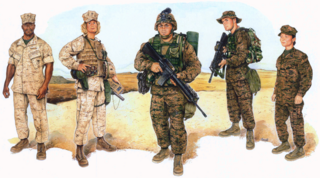
The Marine Corps Combat Utility Uniform (MCCUU) is the current battledress uniform of the United States Marine Corps. It is also worn by Navy personnel assigned to Marine Corps units.

The Universal Camouflage Pattern (UCP) is a digital military camouflage pattern formerly used by the United States Army in their Army Combat Uniform. Technicians at Natick Soldier Systems Center attempted to devise a uniform pattern that would mask the wearer in all seasonal environments. Laboratory and field tests from 2003 to 2004 showed a pattern named "All-Over-Brush" to provide the best concealment of the patterns tested. All-Over-Brush was selected as the winner over ten other patterns. The disadvantage of an all-in-one pattern is that it is a combination of what is effective in many different environments and is less effective in a particular environment when compared to a specialized coloration designed specifically for that environment. The winning All-Over-Brush pattern was not used as the final UCP. Instead, U.S. Army leadership utilized pixellated images taken from Canadian CADPAT and US Marine Corps MARPAT, then recolored them based on three universal colors developed in the Army's 2002-2004 tests, to be called the UCP. While the pixelated pattern of the UCP is similar to the MARPAT and CADPAT camouflage patterns used by the United States Marine Corps and the Canadian Armed Forces, its coloration differs significantly. The final UCP was then adopted without field testing against other patterns.

The lizard pattern is a family of many related designs of military camouflage pattern, first used by the French Army on uniforms from 1947 to the late 1980s. It was based on the British paratroopers' Denison smock. The use of the pattern is widespread in Africa, despite its association with France, because armed factions and militaries tend to obtain them from whichever source has it available.

The U.S. Woodland is a camouflage pattern that was used as the default camouflage pattern issued to the United States Armed Forces from 1981, with the issue of the Battle Dress Uniform, until its replacement in the mid to late 2000s. It is a four color, high contrast disruptive pattern with irregular markings in green, brown, sand and black. It is also known unofficially by its colloquial moniker of "M81" after the Battle Dress Uniform it was first used on, though this term was not officially used by the U.S. military.

The ERDL pattern, also known as the Leaf pattern, is a camouflage pattern developed by the United States Army at its Engineer Research & Development Laboratories (ERDL) in 1948. It was not used until the Vietnam War, when it was issued to elite reconnaissance and special operations units beginning early 1967.
Each branch of the United States Armed Forces has its own uniforms and regulations regarding them.

The Camouflage Central-Europe is the standard camouflage pattern of the French Armed Forces.

Canadian Disruptive Pattern is the computer-generated digital camouflage pattern developed for use by the Canadian Armed Forces. Four operational variations of CADPAT have been used by the Canadian Armed Forces: a temperate woodland pattern, an arid regions pattern, a winter operations pattern, and a multi-terrain pattern.

The Frog Skin, also known as Duck Hunter, is a battledress camouflage pattern with mottle and disruptive coloration to blend into the environment similar to a frog's crypsis skin.
The Navy Working Uniform (NWU) is a series of military uniforms that are currently used by the United States Navy for wear by its members. The NWU is a "working" uniform, which means that it is made to a more durable and utilitarian standard, thus being worn in lieu of more formal uniforms that might get unduly damaged or dirtied in the process of normal military duties.

EMR ; or Universal Camouflage Colourway in English, is a military camouflage pattern in use by the Russian Armed Forces. It is sometimes referred to by the unofficial nicknames RUSPAT, Tetris, Tsifra and Digital Flora. EMR camouflage is the standard camouflage pattern of the Russian Military's VKBO All-Season Uniform.

